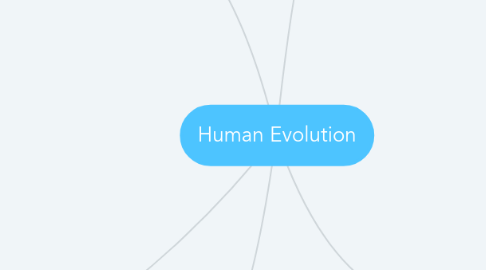
1. Larger mass found in colder environments
2. 4. Archaic Humans
2.1. Earliest appearance was about 350,000 years ago
2.2. Large brain about 1100-1300 cc depending on region
2.3. Neandertals
2.3.1. Europe and Western Asia mainly
2.3.2. Increased brain size
2.3.3. Reduced tooth size
2.3.4. Less skeletal robustness
2.4. Bergmann's Rule
2.4.1. Smaller mass found in warmer environments
2.5. Culture
2.5.1. May have buried their dead
2.5.2. Evidence of flowers around Shanidar 4 burial
2.6. Allen's Rule
2.6.1. Shorter appendages found in colder environments
2.6.2. Longer appendages found in warmer environments
2.7. Late Archaic H. sapiens
2.7.1. Housing shelters
2.7.2. Use of fire
2.7.3. Accumulations of artifacts
3. 1. Early Hominins
3.1. Time Frame
3.1.1. About 6-8 mya
3.1.2. Universe in a year
3.1.2.1. Big Bang: Jan 1
3.1.2.2. Hominins: Dec 31st 9:30 pm
3.2. Characteristics
3.2.1. Bipedal
3.2.1.1. Double-arched foot
3.2.1.2. Basin shaped pelvis
3.2.1.3. Knee angled inward
3.2.2. Large Brain
3.2.3. Complex culture
3.2.4. Non-honing chewing
4. 2. Australopithicines
4.1. Gracile
4.1.1. Belong to Australopithecus genus and have a lighter build (teeth, jaw)
4.1.2. A. afarensis
4.1.2.1. Most well known australopithecine
4.1.2.2. Lucy
4.1.2.2.1. Most complete skeleton of any walking human ancestor
4.1.2.2.2. 40% complete
4.1.3. Oldowan tools
4.1.3.1. Used for butchering, woodworking, and cutting plants
4.1.3.2. Broken intentionally to be sharp
4.1.4. Omnivorous
4.2. Robust
4.2.1. Heavier build in terms of teeth and jaw
4.2.2. Au. africanus
4.2.2.1. Taung Child
4.2.2.1.1. First australopithecine discovered
4.2.2.1.2. 1924
4.2.2.2. South Africa, 2-3 million years ago
4.2.3. Hard seed and nut diet
5. 3. Evolution of Genus Homo
5.1. Characteristics
5.1.1. Increased brain size
5.1.2. Increased body size
5.1.3. Longer stride and shorter arms
5.1.4. Culture!
5.2. Brain Growth
5.2.1. Pros
5.2.1.1. Problem solving skills increase
5.2.1.2. Better communication
5.2.1.3. Flexible in terms of behavior
5.2.2. Cons
5.2.2.1. Higher energy requirements
5.2.2.2. Difficult birth
5.2.2.3. Increased parent investment due to slower development
5.3. Stone Tool Technology
5.3.1. Acheulian, more complex than Oldowan
5.3.2. Hand axes introduced
5.3.3. Wider variety of stones
